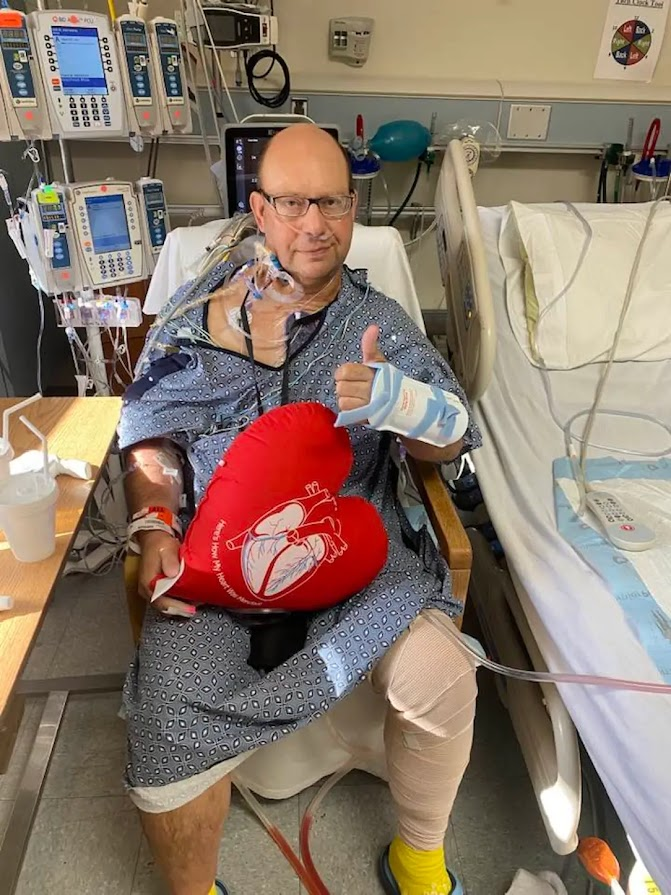Contec TLC9803 3 Lead Holter Monitor
A nice solution for 24 HR HRV
This is an advanced topic that I often get asked about
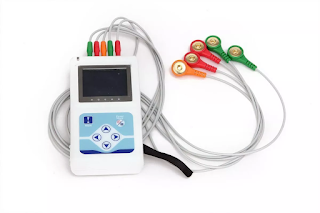
This document is to assist the reader in using the Contec 9803 Three (3) lead Holter Monitor for 24 HR HRV readings. Outside of the First Beat system 24HR HRV recordings and analysis, this system is the only solution attainable without an expensive FDA approved device that has good 24HR HRV reporting. Other methods with a Polar H10 and Phone or Watch connection are outlined below and have their own challenges. This dedicated unit solves most of the frustrations I had with other methods.
In my interest in keeping track of my own health concerns, I became aware of how informative Heart Rate Variability (HRV) Metrics can be in tracking the effects of Adult Onset Diabetes (1,3,5) ( Type 2 Diabetes or T2D ) and associated Coronary Artery Neuropathy(2,4,7) Both of which have affected my overall health. My health biomarkers, and general wellbeing have improved greatly since I have been using HRV to inform my daily health decisions. It’s like having the instrument dashboard on your vehicle only for your health.
Since the fall of 2023 I have been tracking daily short term HRV readings of up to 5 min in Elite HRV. While the short term data is immensely helpful, my concerns about possible Cardiac Autonomic Neuropathy and the overall health of my Vagus Nerve as a complication of my T2D have demonstrated the need for a method of getting reliable 24 HR HRV data so that my homeostatic response to daily circadian cycles, medications and other stressors can be observed over time. The research on these longer term datasets has been well settled for these and other health concerns and I think the effort involved is well worth the health insights. It is my goal to perform 24hr readings 3-4 times per month inorder to observe changes over time in order to average out daily situational stressors with more frequent readings.
Observational Goals and Comparisons for 24HR HRV
- Day / Night SDNN
- Day / Night RMSSD
- Day / Night Total Frequency Power
- Day / Night VLF
- Day / Night LF
- HRV Response to Medications ( Beta Blockers and GLP-1)
- HRV Response to Food Intake ( Logged in My Diary )
- HRV Response to 24 Hr Glucose Monitoring via CGM ( Logged via Abbott Libre 3+)
- HRV and ECG Response to SPO2 while Sleeping ( Logged via Oura Ring and Sleep as Android App with a Berrymed BM2000D Pulse Oximiter )
- HRV Response to Observational Events / Stressors / HRV Resonant Breathing ( Using daily event journal and the Event Button on the TLC9803 )
- Monitoring of Ectopic Heart Rhythms. ( Not Directly HRV Related )
Monitoring of Heart Rate Turbulence ( HRT ) in relation to PVC’s, Is a non-invasive marker of autonomic nervous system function, particularly vagal integrity and baroreflex sensitivity. Impaired HRT can indicate underlying cardiac autonomic neuropathy, which can be associated with various conditions, including diabetes mellitus.
Decoding daily Recovery using Early Sleep Data
We can use the TLC 9803 in a similar manner to Polar's Nightly Recharge feature that uses heart rate (HR) and heart rate variability (HRV) during the first four hours of sleep, and for good reason. This specific timeframe is a critical window for assessing how well your body is recovering from the day's demands, both physical and mental.
The rationale behind this focus lies in the physiology of sleep and the behavior of the autonomic nervous system (ANS). The ANS, which controls involuntary bodily functions, has two main branches: the sympathetic ("fight-or-flight") and parasympathetic ("rest-and-digest") systems.1 Effective recovery is characterized by a shift towards parasympathetic dominance, allowing your body to repair and rejuvenate.
Here's why those first four hours are so important for HR and HRV readings:
Peak Physical Recovery: This initial phase of sleep is when the majority of deep sleep typically occurs. Deep sleep is crucial for physical restoration, muscle repair, and growth hormone release. Monitoring HR and HRV during this period provides direct insight into the body's repair processes.
ANS Calming Assessment: How quickly and effectively your ANS transitions to a parasympathetic state after the day's stressors is a key indicator of recovery. The first few hours of sleep are considered particularly sensitive for reflecting this calming process. A lower heart rate and a higher heart rate variability during this window generally signify that your "rest-and-digest" system has taken the lead, indicating good recovery.
Sensitivity to Stressors: If you've had a particularly stressful day, a late-night workout, consumed alcohol, or are feeling unwell, the impact on your ANS is often most apparent in the early part of your sleep. Your heart rate might remain elevated, and HRV suppressed, for longer than usual, which Nightly Recharge can detect by focusing on this period.
Established Scientific Practice: The selection of a four-hour window is also supported by its use in various scientific studies examining sleep and autonomic nervous system function.
By concentrating on HR and HRV within these initial hours, and using the hourly reporting feature in the TLC 9803 Software 3 Channels ECG Holter System_TF similar data analysis to Polar's Nightly Recharge can provide a more accurate and sensitive measure of your body's overnight recovery.
Previous 24HR HRV Data Collection
I initially attempted 24hr HRV readings with mixed results by using a Polar H10 Chest Strap and my Google Pixel 6 Smartphone. When paired to an app called Polar Sensor Logger, or Polar ECG Analysis, extended readings with HR, RR Intervals and ECG data are possible. The data sets can then be interpreted via EDF Browser and gHRV or Kubios. However I quickly discovered some hardware limitations. The phone needs to be within range of the Polar H10 and the bluetooth connection is not always stable. For some unknown reason the ECG and RR data streams are very subject to drop-outs on the Pixel 6. This left me searching for a more robust solution. Note: Some have had success with a Polar Watch to record the 24HR HRV. I bought a Polar Grit X Pro and used it for a week. I sent it back.. The biometrics are top notch but it fails for me as a smartwatch.. Which for me was a deal breaker.
First Beat Life is an option which I have not tried, but it only focuses on HRV and the reporting, while fantastic, it is subscription based. Other similar devices can be quite expensive and tend to lock their data down in the devices own ecosystem.
Contec Dynamic Holter Systems TLC9803 Holter Monitor
After extensive research, I managed to find the TLC9803. This is a 24HR three lead ECG/EKG Holter Monitor ( With V-, V1, V3, V5 and Neutral Reference Leads). The unit samples at 1000hz. The unit is slightly larger than a cigarette pack and runs on 2 AA Batteries. It comes with it’s own Windows(™) based software on a USB Drive which is designed to perform ECG/EKG waveform analysis as well as a highly useful set of 24HR HRV reports in which the data can be parsed into 5 min or 1hr Segments for analysis. The best thing is the RR Intervals can be exported into a text file which will permit further HRV analysis in the software package of your choice, Kubios, gHRV, Matlab etc. The unit can be found on Ebay or Alibaba under a variety of sellers. I found mine on Ebay from contecmedical002 for $275.00 Shipped from China. I also asked the seller if they would include an extra set of leads which they included at no extra cost to me. Overall I think the unit is a good “open source” 24hr EKG/HRV Monitor.
My initial impressions of the first use of the unit. As I mentioned the unit is about the size of a pack of cigarettes and it comes with a small nylon pouch and neck strap. I found the neck strap to be uncomfortable so I used an elastic strap from one of my athletic chest heart monitors to hold the pouch to my mid section. I had some 3M 2238 Red Dot ECG Electrodes which I used. In order to achieve as few artifacts as possible in the traceings it’s important to prepare the skin under the electrodes properly. If you have any amount of chest hair it is critical that you shave it off. Second you must clean the areas with soap and water and let them dry. Third, you need to use some 220 grit sandpaper and lightly remove the top layer of skin . The last thing I do is a final clean with an alcohol pad. Then you are ready to apply the electrodes. Also if you are active like I am for work, I used a dab of Spectra Tensive electrode adhesive to keep the electrodes on my chest though my work day. There is a diagram in the manual that shows where to place the electrodes. If you plan experiencing lots of body movement for any reason or getting the electrodes wet ( See my note on showering ) I suggest getting some food grade dielectric grease and apply them to the electrode snaps before the wires get connected. This will cut down on artifact noise from movement or moisture. I found the unit to be comfortable to wear and it hid well under my shirt. The electrode wires did not get tangled up and I rarely would feel a wire tug a bit when moving around. The unit has an event button that can be pressed that will time stamp the ECG Strip. I use this along with taking context notes on my phone throughout the day. An example may be I was working on a ladder which may account for extra artifacts. Context is very important to track during a 24HR reading and is the reason I do extended readings multiple times per month in order to evaluate overall trends.

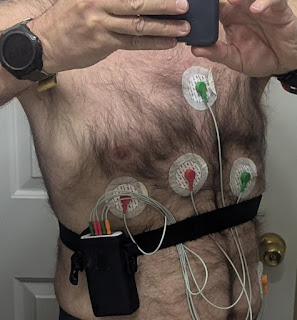
Once the recording is complete the unit is hooked up to the computer that has the software installed and the data file is offloaded into the software which is named 3 Channels ECG Holter System_TF. There is a manual translated from Chinese and a few online Youtube videos. Many are in Spanish and can be translated. One is from Contech but it has no audio, just video of the use of the different features. This may be frustrating but with enough patience once can understand how to use the software and general some very useful 24 HR HRV reports. Overall, a 24 recording can be processed in about 15 Min to include a quick manual artifact check in the “Template” section of the software.
If the goal at this point is to export the RR intervals for analysis in Kubios, gHRV or other HRV software you can follow this link to a YouTube video explanation of the process. There will be no other need to use the Contec software beyond this point.
https://youtu.be/PP2pR9lTiRU?si=SnbR8YA-WnNkLPsyhttps://youtu.be/JtaPGSQDc98?si=tPfMVlBfc2PbXSDyHere are a few data workflow tips:
- Hookup TLC9803 to USB Mini Cable and Computer
- Launch Program
- Fill out the patient info and download the WAVE file on the TLC9803. ( This is pretty automatic )
- Then there is the analysis phase where you try to match the ECG wave the best you can for the best analysis. I have been aligning the left side with the start of the p wave, the middle with the center of the ST, and the right with Q wave.
- For RR Interval Export, with the Template page open you can select the export option under the Arrhythmia Menu at the top. There is no need to use the software further if that is all you need. You can then import your RR data into Kubios, gHRV or other HRV analysis program.
- After this the software will do its best to categorize the different waveform anomalies and sort them via a “Template”. See below for more.
- Mine mostly show up in S or V, Supraventricular or Ventricular Extrasystole
- Go through and make sure each one is properly categorized and that the artifacts are placed in the O file.
- After that you can go through the various report screens and evaluate the data. Fill out the sleep window details for the final multi-page report.
- There is a wealth of HRV data to be evaluated and sorted.
- Physician Notes: I use this field for general notes and events in order to give the data set context. First select what you want to print in the total report section. I click all. Then To Update notes type them in notes and press print and then OK. The notes will save to report and then it will print out. Do this last. Otherwise the notes will not print / save.
Should the Contec software for HRV and EKG reports be desired then the following workflow needs to take place when the data is loaded and analyzed, the software will present several EKG waveform “Templates” where certain anomalies and artifacts will be categorized and presented for the user to review. This step is necessary to ensure that the number of artifacts and ectopic beats are mitigated before the HRV reports are generated. Ectopic heart beats can skew HRV readings so this is important to classify as many as possible. I have also made inquiries with Contec and I am waiting for a response on just how their software handles ectopic beats and artifacts in the calculation or HRV reports.
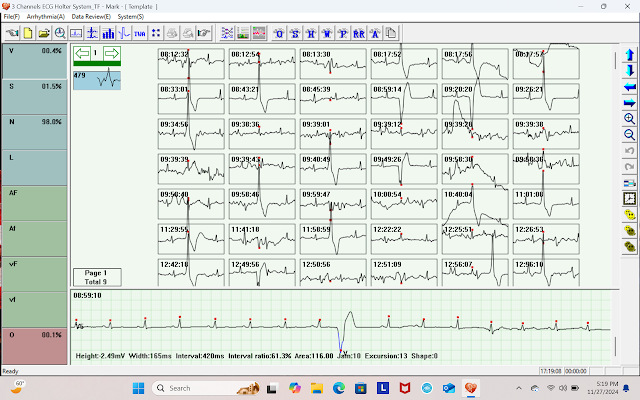
While outside of the scope of this review, the user must familiarize themselves with recognizing typical waveforms as this is where an ECG Holter technician or Physician will utilize their expertise. I have taken the time to recognize what is typical for my data sets and feel comfortable in this regard. This is the point where I will again remind the reader that this is not a medical device and should not be relied upon for diagnosis. There may be information that is gained that would be beneficial to share with a cardiologist and may merit further “Official” testing.
There are a number of YouTube videos or Udemy courses that are typically available for nursing students on the topic of ECG waveforms.
The workflow is outlined here and documented in the manual. This is from Contech with no audio
https://youtu.be/VIdkWQPPD9A?si=sQaEISxCxMrNGzlDHere is a video in Indonesian that does a good job of showcasing the unit and the software. You can select captions and auto-translate them to English.
https://youtu.be/qVmNBNbto40?si=zqsblW8mzNBmWz8o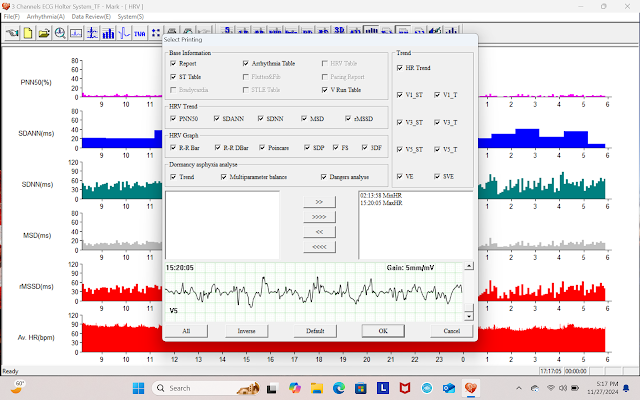
Once you are satisfied with the categorization of ECG waveforms in their respective templates there are several HRV reports to avail yourself of. These include 24 charts of both time and frequency domain which can be sorted in hourly or 5 min segments. There is also a 3D 24HR Frequency domain chart.
A final report can be generated with both ECG Wave categories and HRV metrics. Of special note is a day night comparison of Day / Night SDNN and RMSSD Time Domain, and Total Frequency Power, VLF and LF Frequency Domain. With T2D, overnight recovery indices will be muted indicating an overall sympathetic dominance. You can also look for slight ECG T wave elevations during sleeping hours which in part can indicate Parasympathetic dominance during that time. Also SVT elevation during sleep can be caused by untreated Sleep Apnea.
On the following pages, a sample report follows for a nearly 24HR reading. Please note I was getting over a bad chest cold so this reading has lower than normal HRV scores for me. My Orua ring picked up on this and suggested a few rest days. If you look you can observe a spike in SDNN and LF Frequency around 08:30, this was due to Resonant Frequency Breathwork which really helps increase HRV and it’s very relaxing for me.
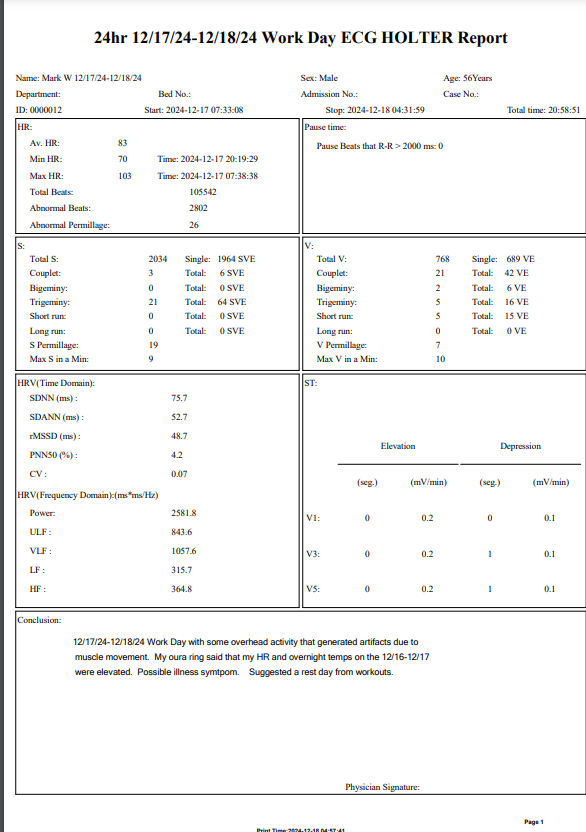
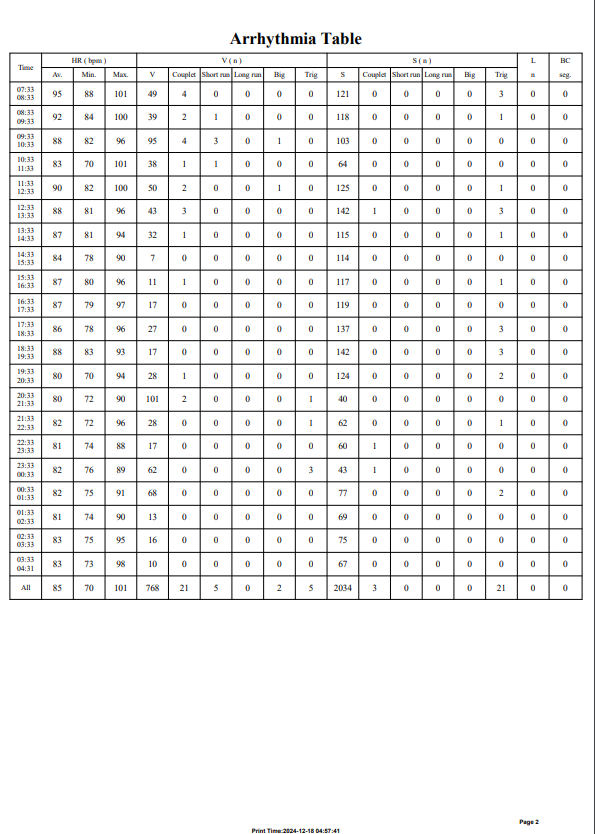
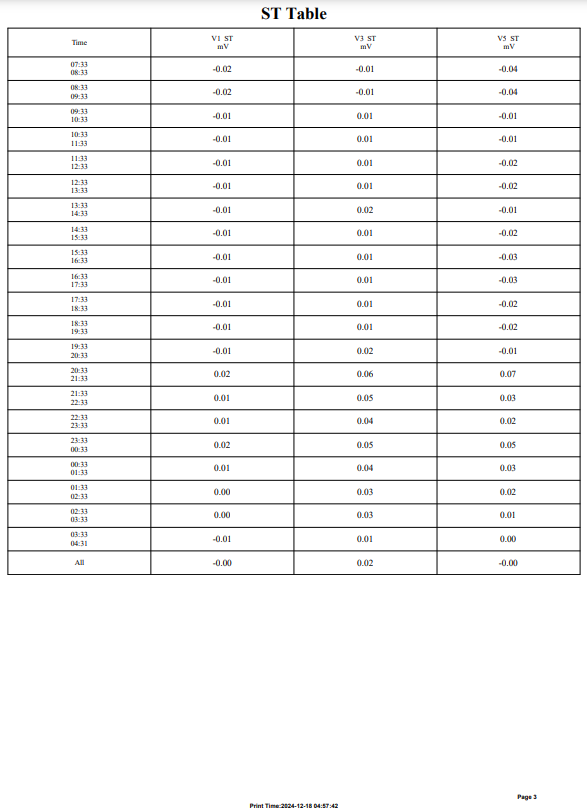
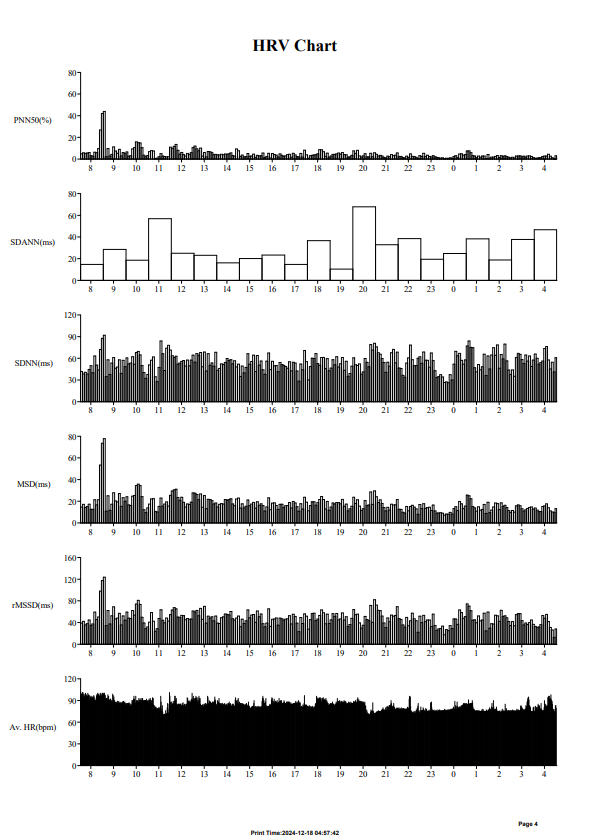
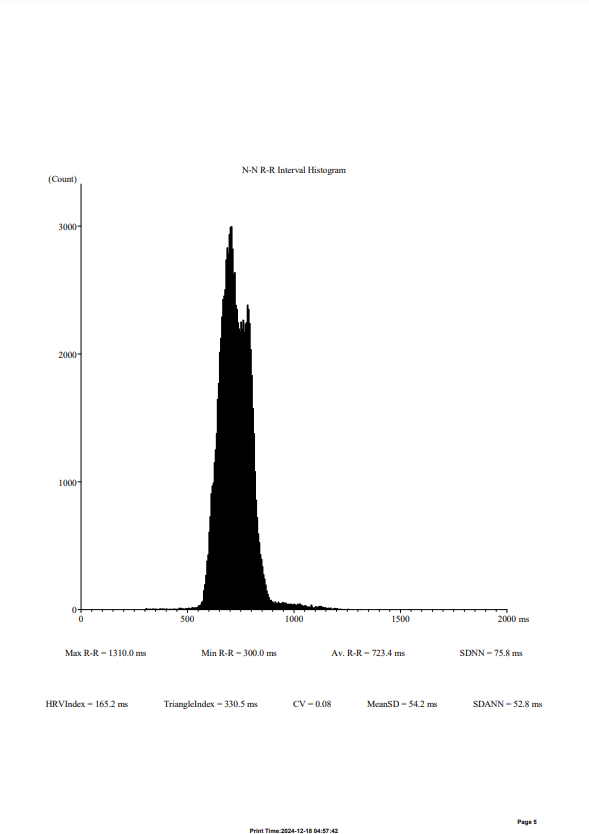
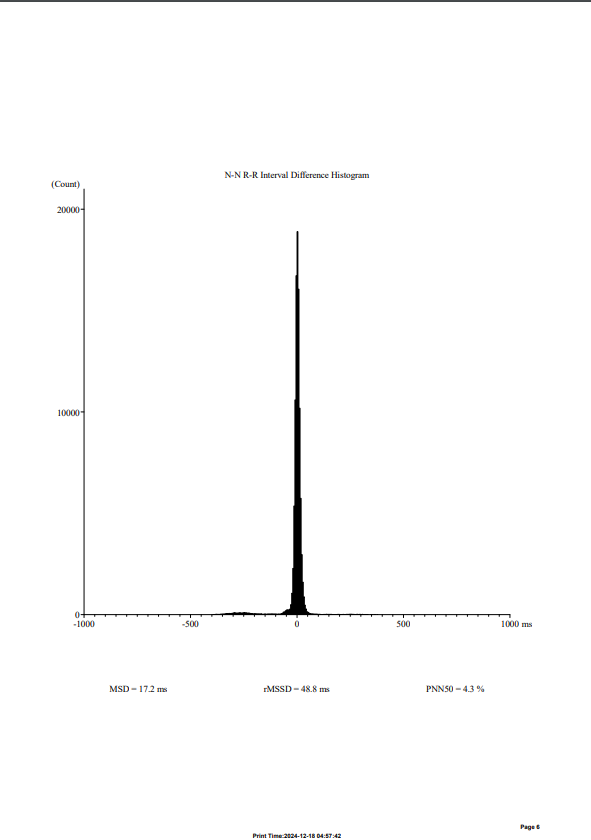
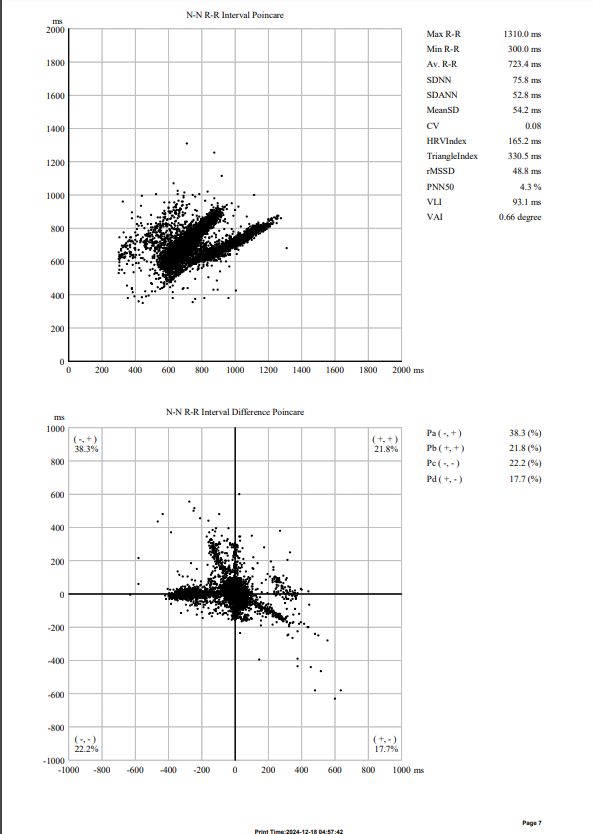
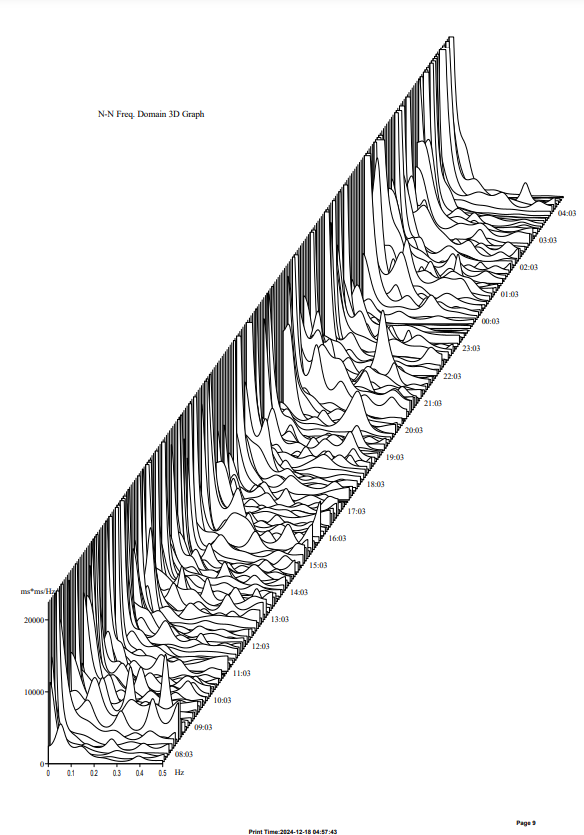
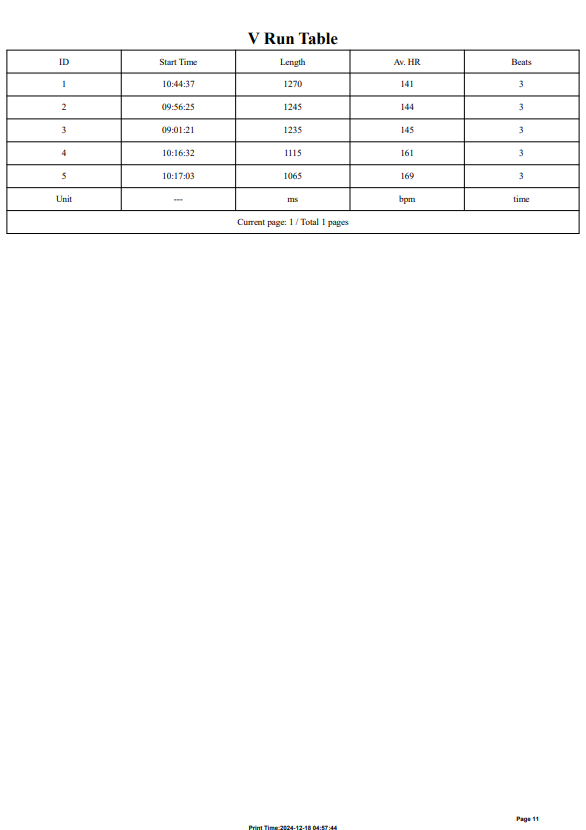
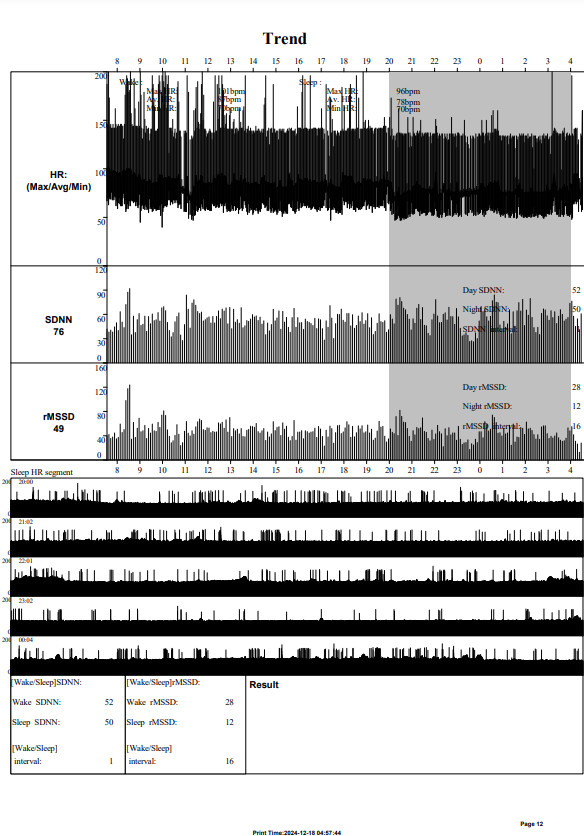
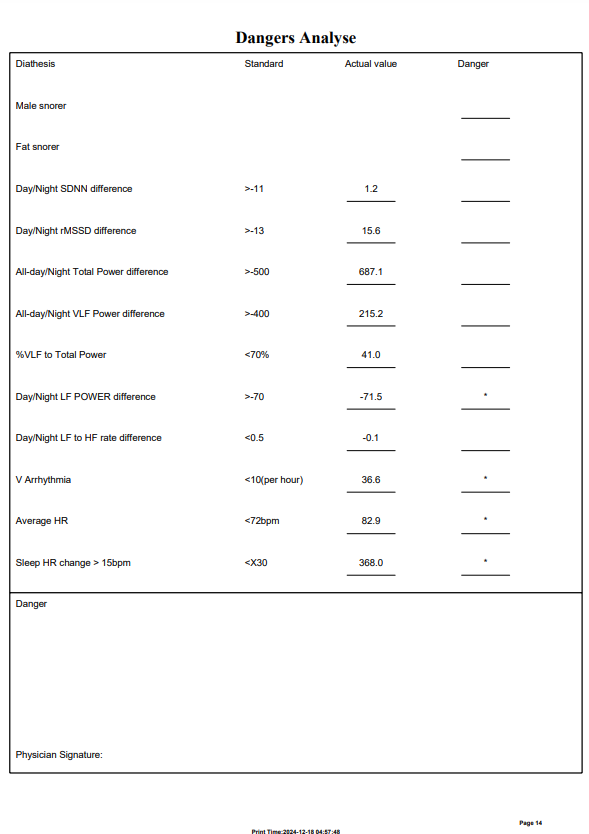
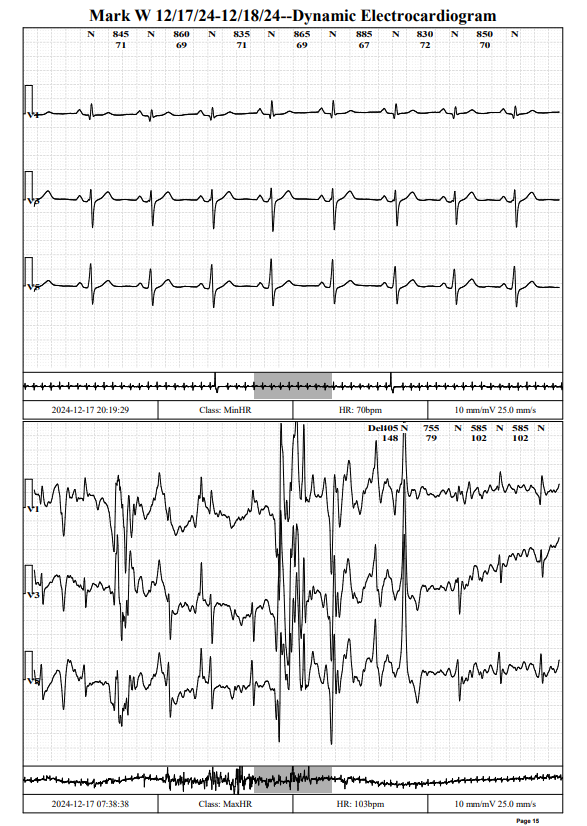
In my opinion this unit is perfectly suited for anyone interested in advanced 24HR HRV studies without too much hassle and without locking oneself into a “Paid” Device Ecosystem.
A Note on the 3M 2238 Electrodes. They are very comfortable and mostly non-irritating to my skin as they mostly have a breathable cloth backing. They will withstand getting wet in the shower and stay adhered to the skin. In this manner the leads can be removed and one can take a shower and go back to another 24HR recording if desired. They are available at Amazon for $18.00 / Bag 50 Note: After continued (Over 24HR) use they can irritate the skin
If you have sensitive skin, you can try the Cardinal Health 7665 Electrodes. They are more expensive but much less irritating for long term wear. They also do well in she show and can be worn for multiple days. These are the ones I use know as I my skin has developed an intolerance to the 3M 2238’s
The TLC 9803 unit is not waterproof, however for showering the unit fits nicely in an waterproof IXP6 Aquapac brand Insulin Pump Case, Size Small. The cables will fit though the cable port if care is taken not to pinch them. I would not submerse the unit in this but showering should be fine if it is worn bandolier style with the cable port pointing down.
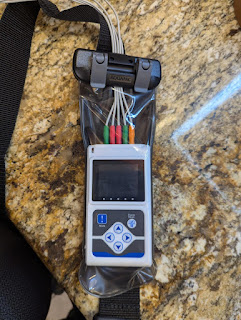
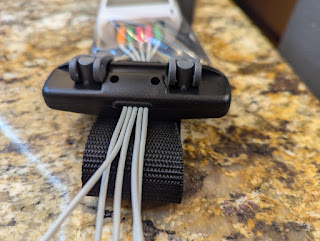
https://aquapac.net/collections/insulin-pumps/products/waterproof-insulin-pump-case-mini?variant=47571035849036
I claim no interest in the product dealers or manufacturers other than I purchased the unit and electrodes for my own research which I hope to share.
Note: I am under the care of a multidisciplinary medical team and this information is meant to augment and advise treatment. I do not use nor suggest that this equipment and information as a replacement for medical advice or devices.
Footnotes:
- https://youtu.be/pLhIXdPxr_s?si=ej_UC4kkQWOSiHaO
- International Scholarly Research Network,ISRN Endocrinology, Volume 2012, Article ID 168264, 7 pages, doi:10.5402/2012/168264 Cardiac Autonomic Neuropathy Measured by Heart Rate Variability and Markers of Subclinical Atherosclerosis in Early Type 2 Diabetes.
- Coopmans C, Zhou TL, Henry RMA, Heijman J, Schaper NC, Koster A, Schram MT, van der Kallen CJH, Wesselius A, den Engelsman RJA, Crijns HJGM, Stehouwer CDA. Both Prediabetes and Type 2 Diabetes Are Associated With Lower Heart Rate Variability: The Maastricht Study. Diabetes Care. 2020
- May;43(5):1126-1133. doi: 10.2337/dc19-2367. Epub 2020 Mar 11. PMID: 32161051.
- Serra C, Sestu A, Murru V, Greco G, Vacca M, Scuteri A. Diabetes Affects the Relationship between Heart Rate Variability and Arterial Stiffness in a Gender-Specific Manner. J Clin Med. 2022 Aug 23;11(17):4937. doi: 10.3390/jcm11174937. PMID: 36078867; PMCID: PMC9456306.
- Nganou-Gnindjio CN, Mba CM, Azabji-Kenfack M, Dehayem MY, Mfeukeu-Kuate L, Mbanya JC, Sobngwi E. Poor glycemic control impacts heart rate variability in patients with type 2 diabetes mellitus: a cross sectional study. BMC Res Notes. 2018 Aug 20;11(1):599. doi: 10.1186/s13104-018-3692-z. PMID: 30126442; PMCID: PMC6102889.
- Xuan, M., Shen, Y., Tang, W. et al. Effect of slow deep breathing on cardiovascular autonomic neuropathy in type 2 diabetes mellitus patients. Diabetol Metab Syndr 17, 330 (2025). https://doi.org/10.1186/s13098-025-01862-x
I can be reached at:
hrvtrinityblog@gmail.com for any comments on this.
I hope that this information is found to be beneficial to you.
Mark Weiss

